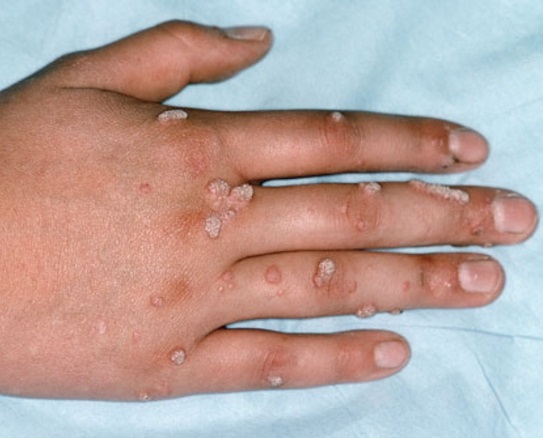 |
| Warts on Hand |
Warts are noncancerous skin growths caused by a viral infection in the skin's top layer or mucous membranes. Wart-causing viruses are members of the human papillomavirus "family" (HPV). A wart's presence is determined by where it grows. Warts are usually skin-colored and rough to the touch, but they may also be dark, flat, or smooth.
Warts come in a variety of shapes and sizes. The first one I'll tell you about is known as typical warts. Common warts appear on the fingertips, the backs of the hands, and around the nails. They are most prevalent in areas where skin has been torn, such as when fingernails are bitten or hangnails are pulled.
Foot warts are the second category of wart. Foot warts, also known as plantar warts, are usually found on the soles of the foot. Mosaic warts form as plantar warts emerge in clusters. Most plantar warts do not protrude because walking flattens and drives them back into the flesh. These warts frequently have black spots that are blood vessels.
Flat warts are the third category of wart. Flat warts are thinner and cleaner than other wart forms. They seem to proliferate in large numbers. They will rise from twenty to one hundred in a single day. They can appear anywhere, but they are more popular on the face of infants. Adults commonly see them in the beard region of men and the legs of women. This is most likely due to shaving irritation.
Many individuals develop warts without ever realizing it. It all depends on the kind of wart you come into touch with. Depending to where they are on the body, certain warts can be uncomfortable and even cause burns.
Warts are most often handed on from person to person, often implicitly. The period between the first touch and the appearance of the warts is often several months. The likelihood of contracting hand, foot, or flat warts is low. Wearing shower thongs and taking care of one's hands and feet will help to keep warts at bay. It seems the genital warts are more infectious. It is important to take care to prevent the spread of genital warts.
Few citizens will receive pieces, and others will not. It is just a matter of how they come into contact with them. Here's how to get rid of warts if you come into touch with them. Warts often vanish on their own over a span of months or years. However, since warts can spread to other people or new parts of the body, most people should be treated, particularly if the warts are bothersome or painful.
Any individuals will get them burnt off with acid or frozen off of it. Both of these techniques are painful, however they work. Any wart treatments are available without a prescription. You might, though, confuse another form of skin growth for a wart and end up treating something bad as though it were a wart. If you have any concerns about the diagnosis or treatment of a wart, you should see a doctor.
Thank you for this post.
ReplyDelete